Three Decades of Tillage Driven Topsoil Displacement and Soil Erosion Attenuation on Loess Plateau Slope Farmlands
Abstract
1. Introduction
2. Materials and Methods
2.1. Geographic Setting
2.2. Universal Soil Loss Equation (USLE)
2.2.1. Rainfall Erosivity Factor (R)
2.2.2. Soil Erodibility Factor (K)
2.2.3. Topographic Factor (L × S)
2.2.4. Cover and Management Factor (C)
2.2.5. Support Practice Factor (P)
2.3. On-Site Data Estimation
3. Results
3.1. Physical Indicators of Cultivated Soil
3.2. Soil Loss in Cultivated Land
3.3. Leveling Mechanism in Cultivated Land
4. Discussion
4.1. Erosion Mitigation Characteristics of Indigenous Flora
4.2. Dam Effect of Hoeing Methods
4.3. Water Storage Effect of Straw Returning
5. Conclusions
Author Contributions
Funding
Institutional Review Board Statement
Data Availability Statement
Conflicts of Interest
References
- Tang, B.; Jiao, J.; Zhang, Y.; Chen, Y.; Wang, N.; Bai, L. The Magnitude of soil erosion on hillslopes with different land use patterns under an extreme rainstorm on the Northern Loess Plateau, China. Soil Tillage Res. 2020, 204, 104716. [Google Scholar] [CrossRef]
- Chen, W.; Huang, Y.; Lebar, K.; Bezak, N. A systematic review of the incorrect use of an empirical equation for the estimation of the rainfall erosivity around the globe. Earth-Sci. Rev. 2023, 238, 104339. [Google Scholar] [CrossRef]
- Smith, R.; Goodrich, D.; Quinton, J. Dynamic, distributed simulation of watershed erosion: The Kineros2 and Eurosem Models. J. Soil Water Conserv. 1995, 50, 517–520. [Google Scholar] [CrossRef]
- Flanagan, D.; Ascough, J.; Nearing, M.; Laflen, J. The water erosion prediction project (WEPP) model. In Landscape Erosion and Evolution Modelling; Harmon, R., Doe, W., Eds.; Springer: New York, NY, USA, 2001; pp. 145–199. [Google Scholar]
- Kohrell, G.; Mulla, D.; Gelder, B. Calibration and validation of hillslope runoff and soil loss outputs from the Water Erosion Prediction Project model in Minnesota agricultural watersheds. J. Am. Water Resour. Assoc. 2023, 59, 1529–1548. [Google Scholar] [CrossRef]
- Morgan, R.; Quinton, J.; Smith, R.; Govers, G.; Poesen, J.; Auerswald, K.; Chisci, G.; Torri, D.; Styczen, M. The European soil erosion model (EUROSEM): A process-based approach for predicting soil loss from fields and small catchments. Earth Surf. Process. Landf. 1998, 23, 527–544. [Google Scholar] [CrossRef]
- De Roo, A.; Offermans, R.; Cremers, N. LISEM: A single-event, physically based hydrological and soil erosion model for drainage basins. II: Sensitivity analysis, validation and application. Hydrol. Process. 1996, 10, 1119–1126. [Google Scholar] [CrossRef]
- Pandey, S.; Kumar, P.; Zlatic, M.; Nautiyal, R.; Panwar, V. Recent advances in assessment of soil erosion vulnerability in a watershed. Int. Soil Water Conserv. Res. 2021, 9, 305–318. [Google Scholar] [CrossRef]
- Benavidez, R.; Jackson, B.; Maxwell, D.; Norton, K. A review of the (Revised) Universal Soil Loss Equation ((R)USLE): With a view to increasing its global applicability and improving soil loss estimates. Hydrol. Earth Syst. Sci. 2018, 22, 6059–6086. [Google Scholar] [CrossRef]
- Morgan, R. A Simple Approach to Soil Loss Prediction: A revised Morgan-Morgan-Finney model. CATENA 2001, 44, 305–322. [Google Scholar] [CrossRef]
- Rakhimova, M.; Zulpykharov, K.; Assylbekova, A.; Zhengissova, N.; Taukebayev, O. Using the revised universal soil loss equation and global climate models (CMIP6) to predict potential soil brosion associated with climate change in the Talas District. Kazakhstan. Sustainability 2024, 16, 574. [Google Scholar] [CrossRef]
- Li, Q.; Liu, G.; Zhang, Z.; Tuo, D.; Bai, R.; Qiao, F. Relative contribution of root physical enlacing and biochemistrical exudates to soil erosion resistance in the Loess soil. CATENA 2017, 153, 61–65. [Google Scholar] [CrossRef]
- Zhao, G.; Gao, P.; Tian, P.; Sun, W.; Hu, J.; Mu, X. Assessing sediment connectivity and soil erosion by water in a representative catchment on the Loess Plateau, China. CATENA 2020, 185, 104284. [Google Scholar] [CrossRef]
- Zhang, Y.; Li, P.; Liu, X.; Xiao, L.; Shi, P.; Zhao, B. Effects of farmland conversion on the stoichiometry of carbon, nitrogen, and phosphorus in soil aggregates on the Loess Plateau of China. Geoderma 2019, 351, 188–196. [Google Scholar] [CrossRef]
- Morbidelli, R.; Saltalippi, C.; Flammini, A.; Cifrodelli, M.; Corradini, C.; Govindaraju, R. Infiltration on sloping surfaces: Laboratory experimental evidence and implications for infiltration modeling. J. Hydrol. 2015, 523, 79–85. [Google Scholar] [CrossRef]
- Zhang, Y.; Li, P.; Liu, X.; Xiao, L. Changes in soil aggregate fractions, stability, and associated organic carbon and nitrogen in different land use types in the Loess Plateau, China. Sustainability 2022, 14, 3963. [Google Scholar] [CrossRef]
- Gaspar, L.; Quijano, L.; Lizaga, I.; Navas, A. Effects of land use on soil organic and inorganic C and N at 137Cs traced erosional and depositional sites in mountain agroecosystems. CATENA 2019, 181, 104058. [Google Scholar] [CrossRef]
- Dalzell, B.; Fissore, C.; Nater, E. Topography and land use impact erosion and soil organic carbon burial over decadal timescales. CATENA 2022, 218, 106578. [Google Scholar] [CrossRef]
- Naipal, V.; Reick, C.; Pongratz, J.; Van Oost, K. Improving the global applicability of the RUSLE model—Adjustment of the topographical and rainfall erosivity factors. Geosci. Model Dev. 2015, 8, 2893–2913. [Google Scholar] [CrossRef]
- Phinzi, K.; Ngetar, N. The Assessment of water-borne erosion at catchment level using GIS-Based RUSLE and remote Sensing: A review. Int. Soil Water Conserv. Res. 2019, 7, 27–46. [Google Scholar] [CrossRef]
- Li, S.; Li, C.; Yao, D.; Liu, C.; Zhang, Y. Multiscale nonlinear analysis of failure mechanism of loess-mudstone landslide. CATENA 2022, 213, 106188. [Google Scholar] [CrossRef]
- Sun, W.; Shao, Q.; Liu, J. Soil erosion and its response to the changes of precipitation and vegetation cover on the Loess Plateau. J. Geogr. Sci. 2013, 23, 1091–1106. [Google Scholar] [CrossRef]
- Zhao, G.; Mu, X.; Jiao, J.; An, Z.; Klik, A.; Wang, F.; Jiao, F.; Yue, X.; Gao, P.; Sun, W. Evidence and causes of spatiotemporal changes in runoff and sediment yield on the chinese loess plateau. Land Degrad. Dev. 2017, 28, 579–590. [Google Scholar] [CrossRef]
- Bagherzadeh, A. Estimation of soil losses by USLE model using GIS at Mashhad plain, Northeast of Iran. Arab. J. Geosci. 2014, 7, 211–220. [Google Scholar] [CrossRef]
- Das, S.; Deb, P.; Bora, P.; Katre, P. Comparison of RUSLE and MMF soil loss models and evaluation of catchment scale best management Practices for a Mountainous Watershed in India. Sustainability 2020, 13, 232. [Google Scholar] [CrossRef]
- Qu, L.; Liu, Y.; Li, Y.; Wang, J.; Yang, F.; Wang, Y. Sustainable use of gully agricultural land and water resources for sustainable development goals: A case study in the loess plateau of China. Land Degrad. Dev. 2023, 34, 4935–4949. [Google Scholar] [CrossRef]
- Yan, R.; Zhang, X.; Yan, S.; Chen, H. Estimating soil erosion response to land use/cover change in a catchment of the Loess Plateau, China. Int. Soil Water Conserv. Res. 2018, 6, 13–22. [Google Scholar] [CrossRef]
- Panagos, P.; Borrelli, P.; Meusburger, K.; Yu, B.; Klik, A.; Lim, K.; Yang, J.; Ni, J.; Miao, C.; Chattopadhyay, N.; et al. Global rainfall erosivity assessment based on high-temporal resolution rainfall records. Sci. Rep. 2017, 7, 4175. [Google Scholar] [CrossRef]
- Li, L.; Wang, Y.; Liu, C. Effects of land use changes on soil erosion in a fast developing area. Int. J. Environ. Sci. Technol. 2014, 11, 1549–1562. [Google Scholar] [CrossRef]
- Chen, L.; Qian, X.; Shi, Y. Critical area ldentification of potential soil loss in a typical watershed of the three gorges reservoir region. Water Resour. Manag. 2011, 25, 3445–3463. [Google Scholar] [CrossRef]
- Zhou, S.; Li, P.; Zhang, Y.; Zhang, N.; Cao, Y. Formation of new erosion-deposition patterns after farmland conversion: The major role of topography. CATENA 2023, 231, 107349. [Google Scholar] [CrossRef]
- Ozsoy, G.; Aksoy, E.; Dirim, M.; Tumsavas, Z. Determination of soil erosion risk in the Mustafakemalpasa river basin, Turkey, using the revised universal soil loss equation, geographic information system, and remote sensing. Environ. Manag. 2012, 50, 679–694. [Google Scholar] [CrossRef] [PubMed]
- Wang, C.; Fu, X.; Wang, B.; Gong, Z.; Zhang, G.; Wang, X. Modeling feedback processes between soil detachment and sediment transport along hillslopes on the Loess Plateau of China. Sci. Total Environ. 2023, 901, 166032. [Google Scholar] [CrossRef] [PubMed]
- Morgan, R. Soil Erosion and Conservation; Cranfield University, National Soil Resources Institute: Cranfield, UK, 2005. [Google Scholar]
- Kulikov, M.; Schickhoff, U.; Borchardt, P. Spatial and seasonal dynamics of soil loss ratio in mountain rangelands of south-western Kyrgyzstan. J. Mt. Sci. 2016, 13, 316–329. [Google Scholar] [CrossRef]
- Liu, M.; Li, P.; Liu, M.; Wang, J.; Chang, Q. The trend of soil organic carbon fractions related to thesuccessions of different vegetation types on the tableland of the loess plateau of China. J. Soils Sediments 2020, 21, 203–214. [Google Scholar] [CrossRef]
- Luo, J.; Zheng, Z.; Li, T.; He, S.; Zhang, X.; Huang, H.; Wang, Y. Quantifying the contributions of soil surface microtopography and sediment concentration to rill erosion. Sci. Total Environ. 2021, 752, 141886. [Google Scholar] [CrossRef]
- Sadeghi, S.; Harchegani, M.; Asadi, H. Variability of particle size distributions of upward/downward splashed materials in different rainfall intensities and slopes. Geoderma 2017, 290, 100–106. [Google Scholar] [CrossRef]
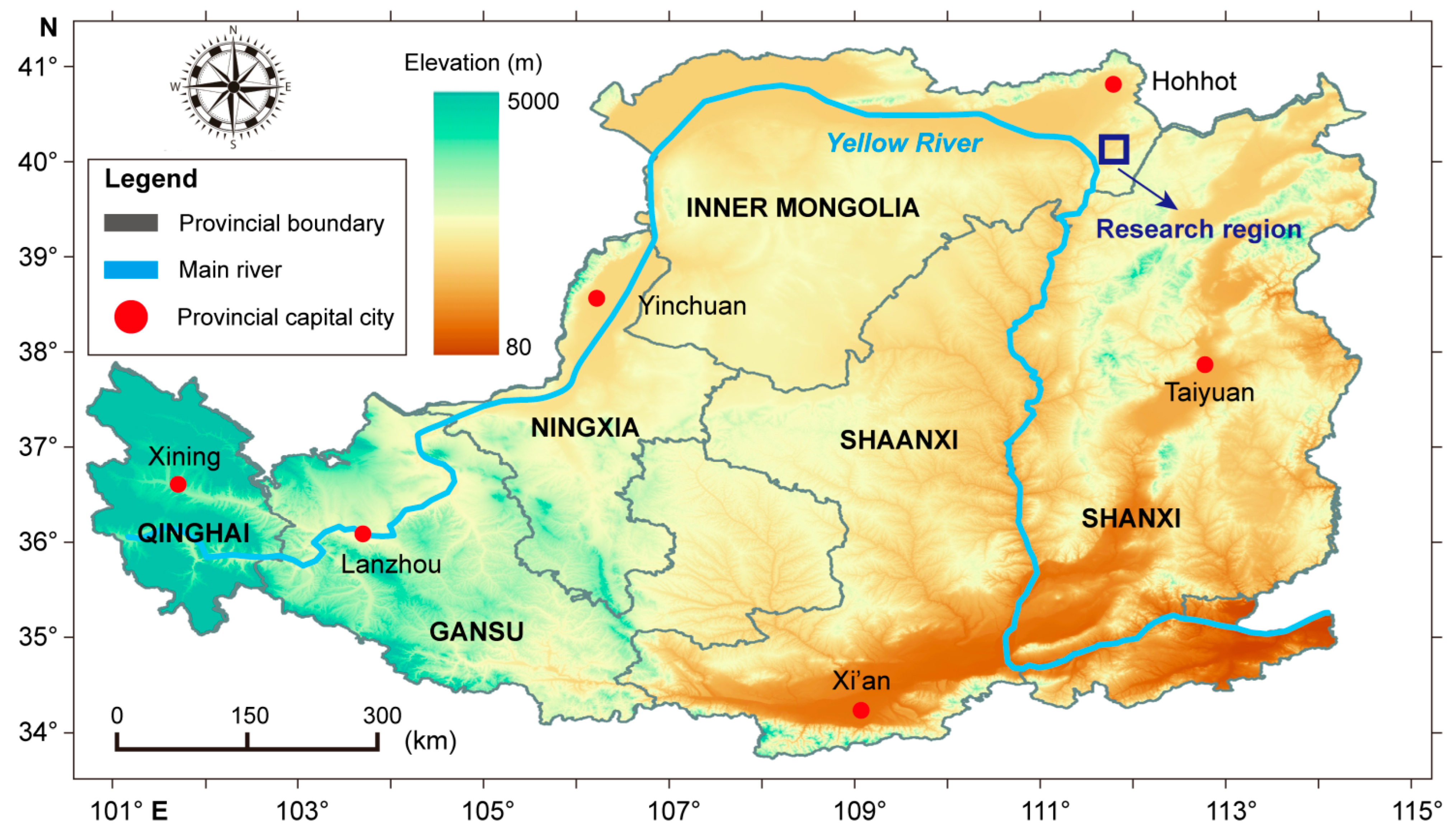

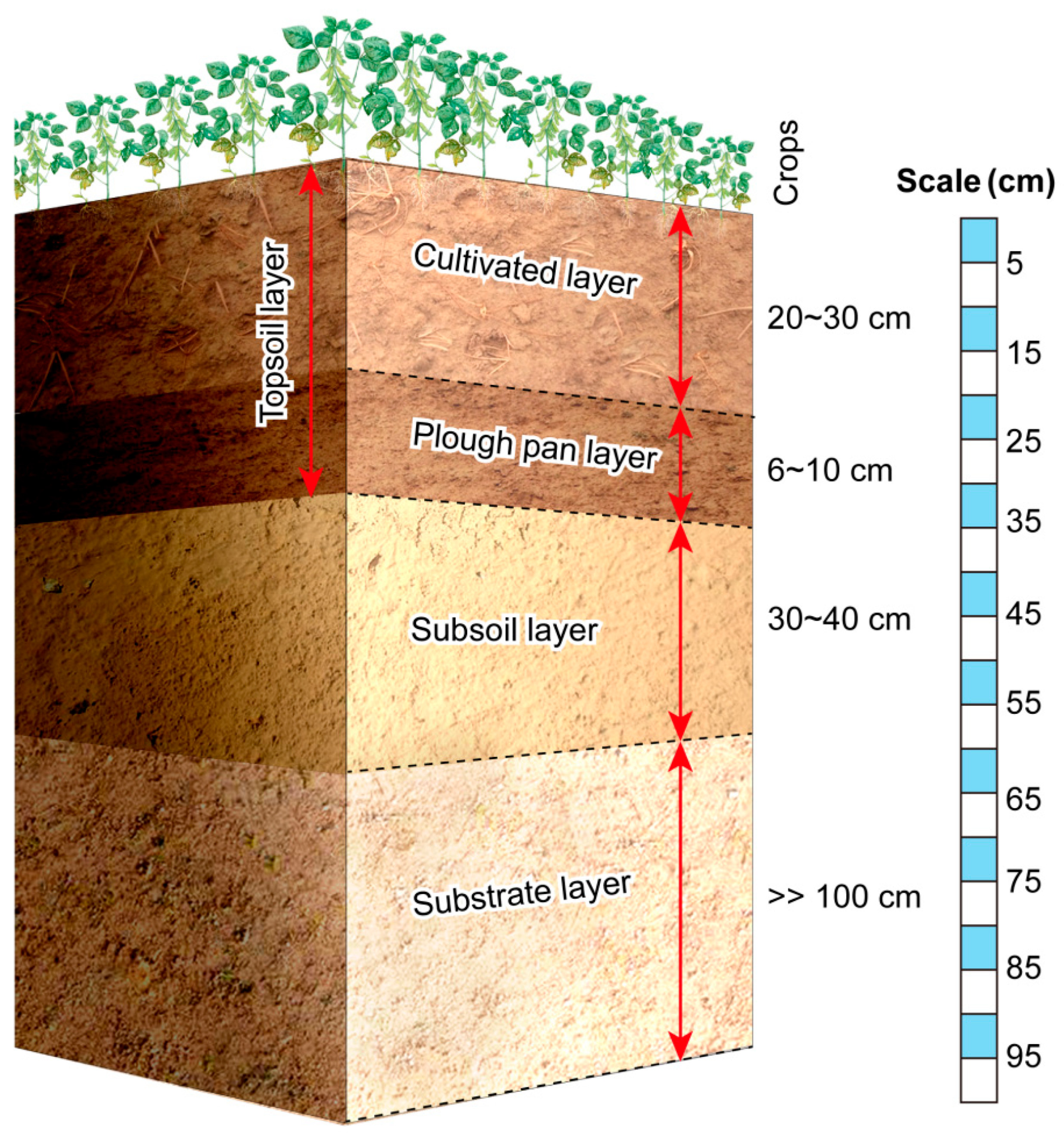
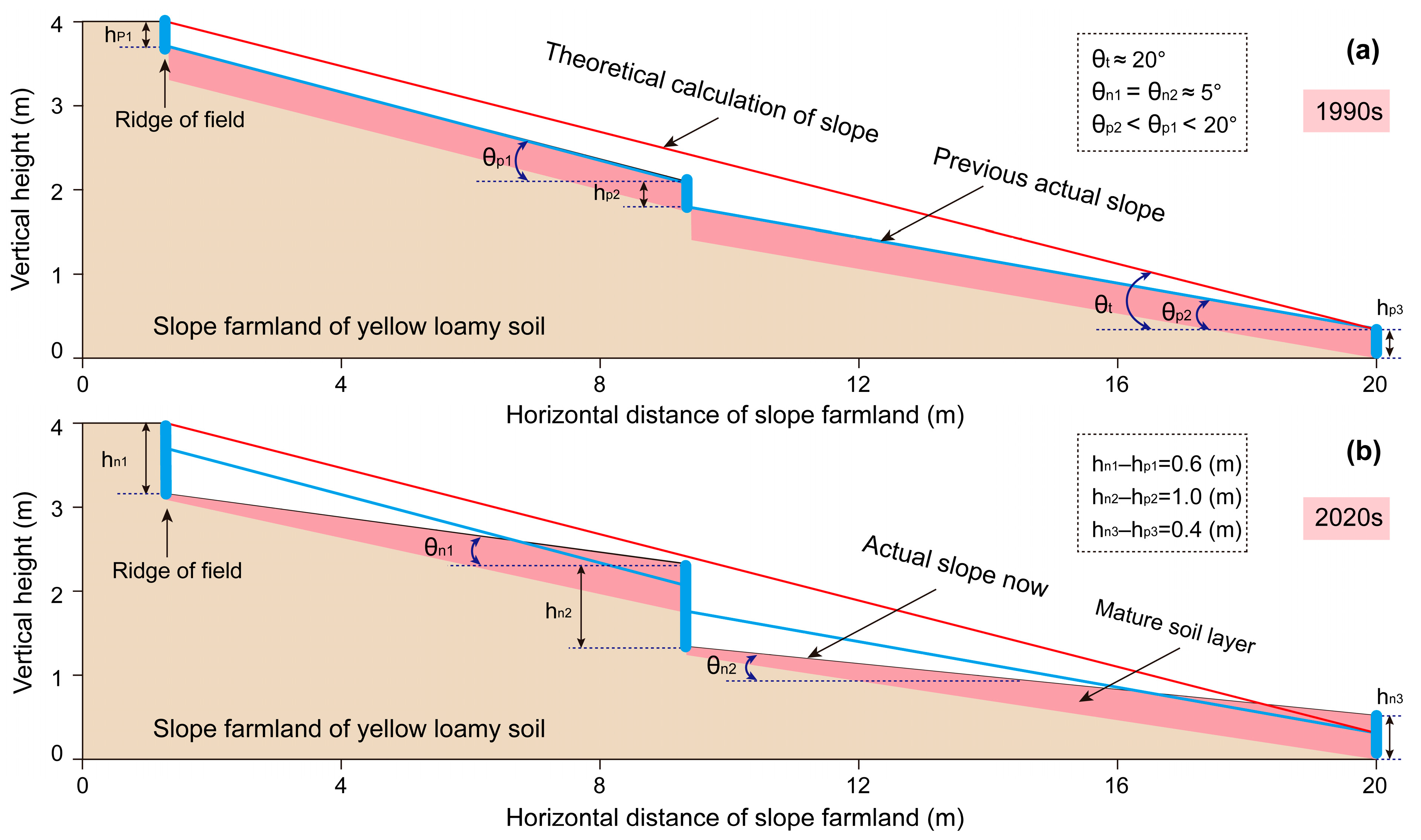
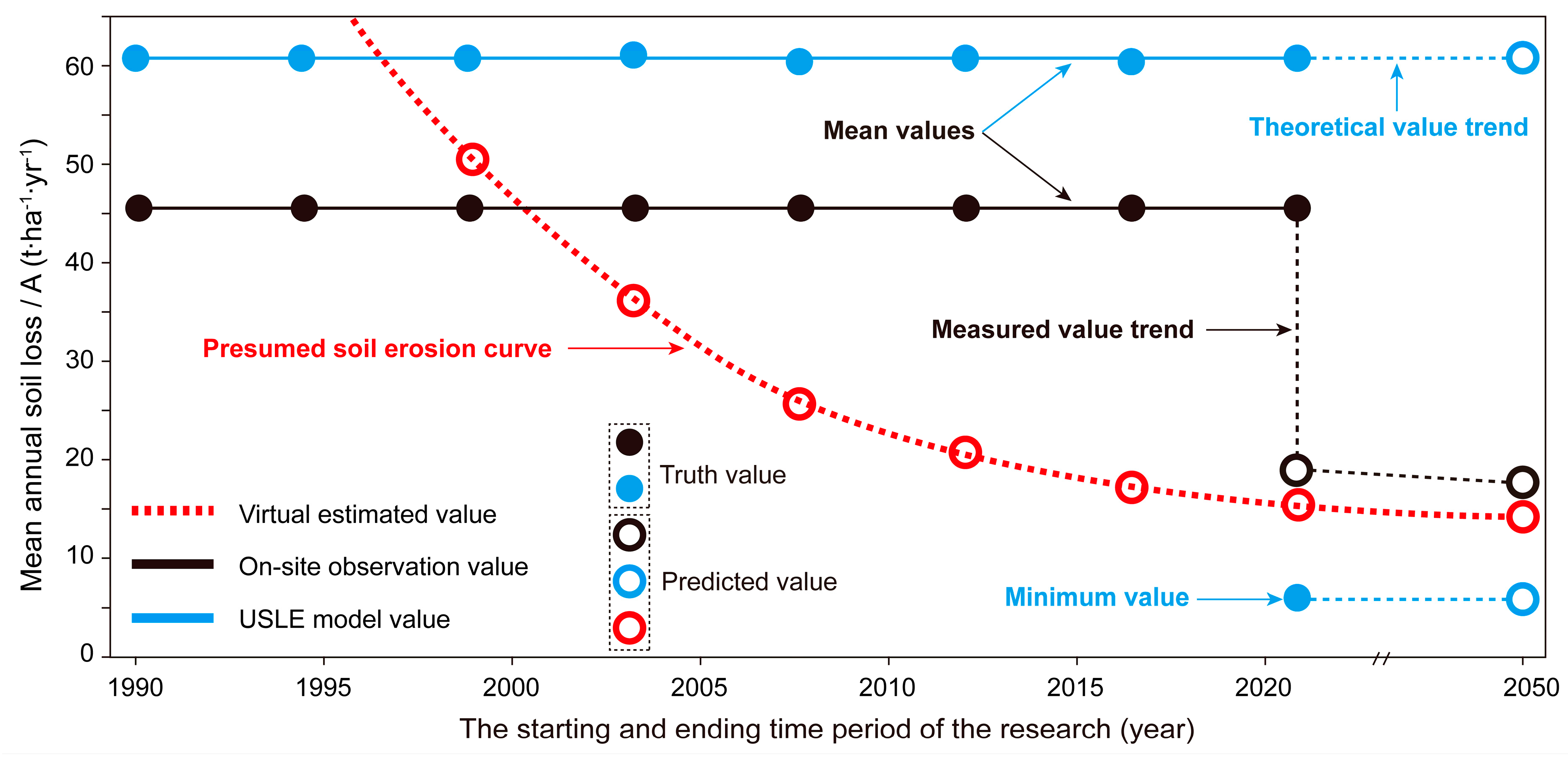
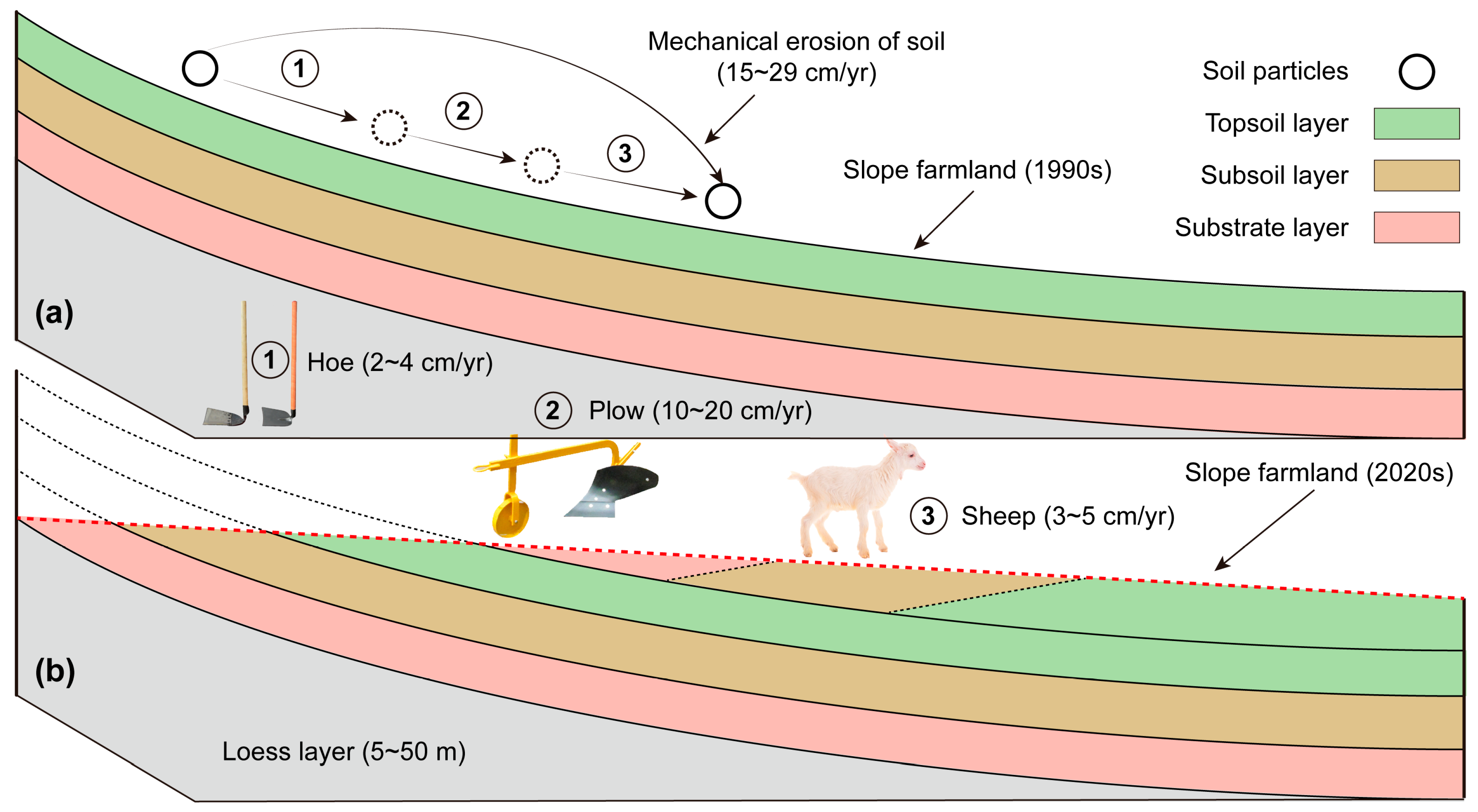
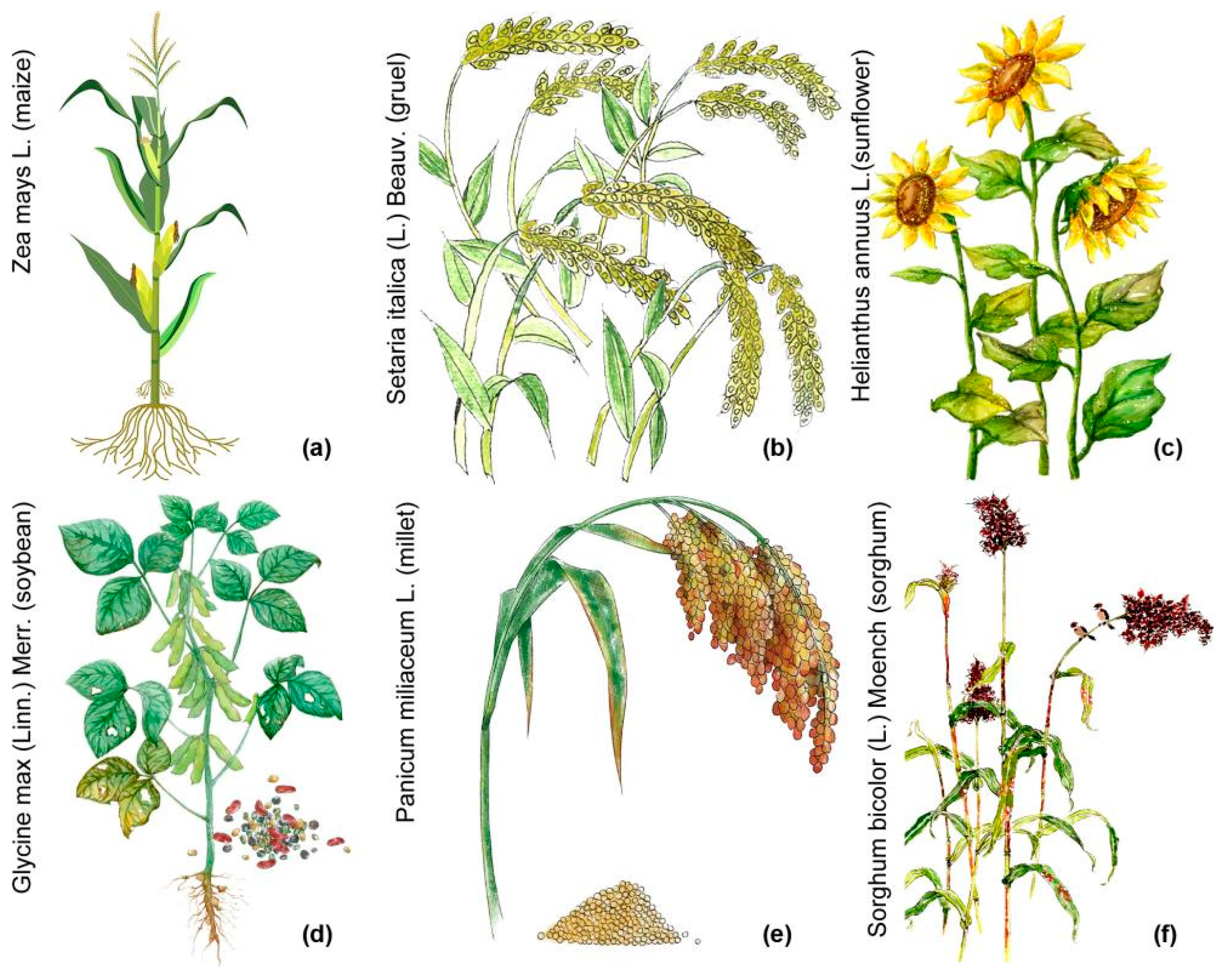
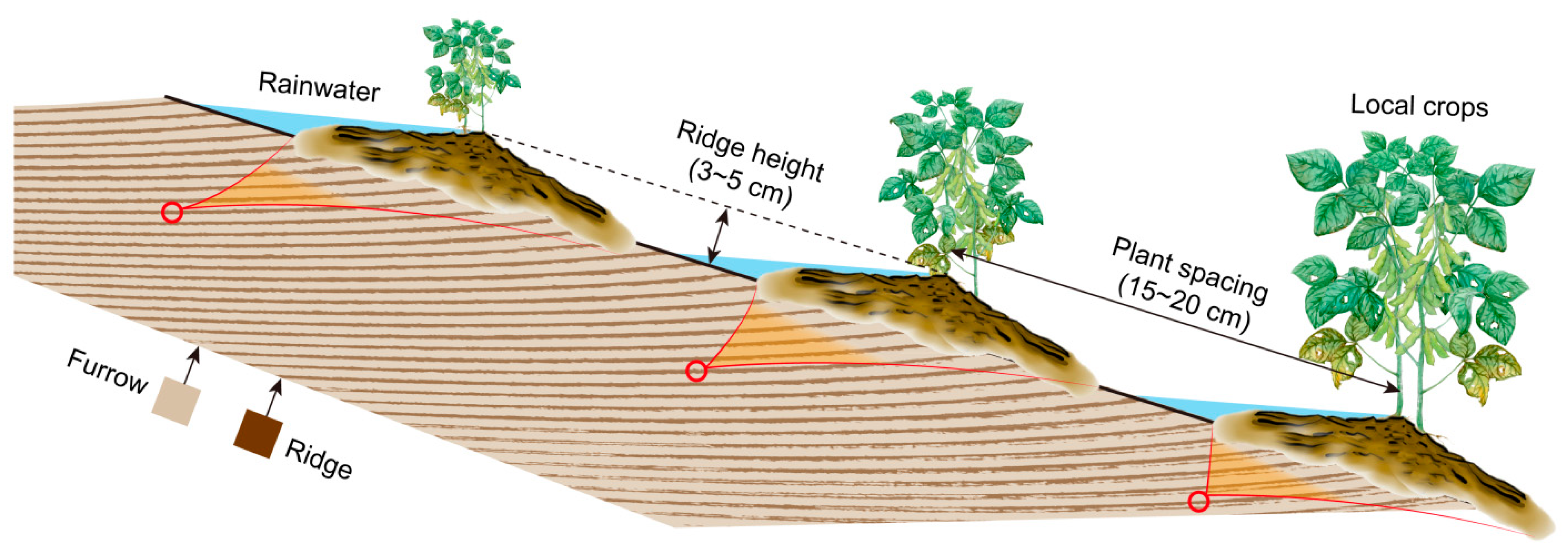
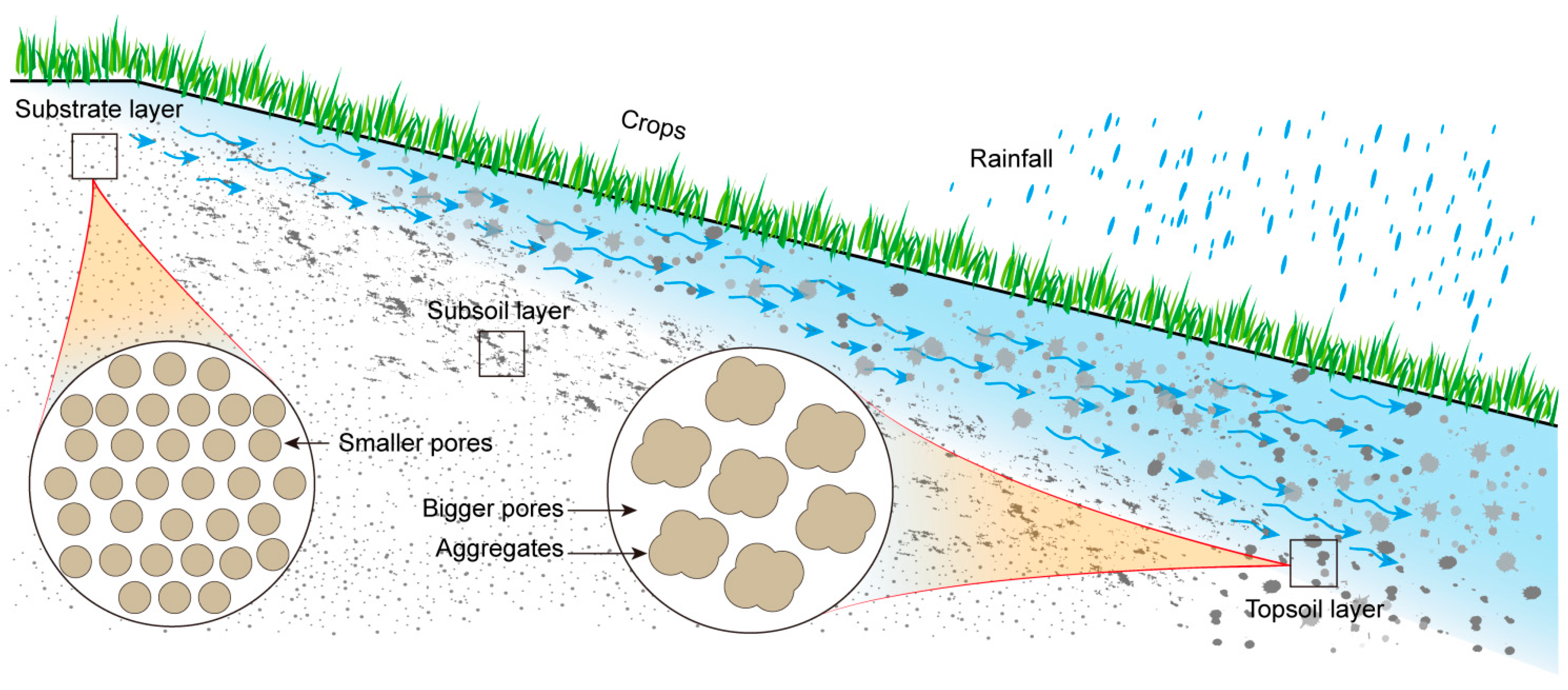
| NO. | Province | Factor (t·ha·h·ha−1·MJ−1·mm−1) | ||
|---|---|---|---|---|
| Mean Value | Maximum Value | Minimum Value | ||
| 1 | Shanxi | 0.040 | 0.045 | 0.010 |
| 2 | Shaanxi | 0.036 | 0.045 | 0.010 |
| 3 | Henan | 0.037 | 0.045 | 0.021 |
| 4 | Inner Mongolia | 0.029 | 0.045 | 0.012 |
| 5 | Ningxia | 0.035 | 0.045 | 0.010 |
| 6 | Gansu | 0.039 | 0.045 | 0.010 |
| 7 | Qinghai | 0.037 | 0.045 | 0.010 |
| Crop | No. | Management | Factor |
|---|---|---|---|
| Maize, Sorghum, Millet | 1 | High productivity; conventional tillage | 0.20~0.55 |
| 2 | Low productivity; conventional tillage | 0.50~0.90 | |
| 3 | High productivity; chisel ploughing into residue | 0.12~0.20 | |
| 4 | Low productivity; chisel ploughing into residue | 0.30~0.45 | |
| 5 | High productivity; no or minimum tillage | 0.02~0.10 |
| No. | Land Type | Factor |
|---|---|---|
| 1 | Cultivated land | 0.35 |
| 2 | Shrubs | 0.75 |
| 3 | Forest land | 0.80 |
| 4 | Grassland | 0.90 |
| 5 | Bare land | 1.00 |
| Soil Bulk Density (g/cm3) | Moisture Content (%) | Porosity (%) | Matter Content (g/kg) | PH | Particle Size Composition of Yellow Loamy Soil | ||
|---|---|---|---|---|---|---|---|
| Sand (0.02~2 mm) | Silt (0.002~0.02 mm) | Clay (<0.002 mm) | |||||
| 1.35 | 12.30 | 46.20 | 10.60 | 8.10 | 66.20 | 30.50 | 3.30 |
| Index | Factor | Factor | Factor | Factor | Factor | Factor | |
|---|---|---|---|---|---|---|---|
| Calculated value (20°) | 62.48 | 523.74 | 0.029 | 6.00 | 6.53 | 0.30 | 0.35 |
| Calculated value (5°) | 6.50 | 523.74 | 0.029 | 4.20 | 0.97 | 0.30 | 0.35 |
| Measured value (average value) | 45.67 | - | - | - | - | - | - |
Disclaimer/Publisher’s Note: The statements, opinions and data contained in all publications are solely those of the individual author(s) and contributor(s) and not of MDPI and/or the editor(s). MDPI and/or the editor(s) disclaim responsibility for any injury to people or property resulting from any ideas, methods, instructions or products referred to in the content. |
© 2025 by the authors. Licensee MDPI, Basel, Switzerland. This article is an open access article distributed under the terms and conditions of the Creative Commons Attribution (CC BY) license (https://creativecommons.org/licenses/by/4.0/).
Share and Cite
Li, S.; Zhao, B.; Wu, H.; Li, R.; Wang, P. Three Decades of Tillage Driven Topsoil Displacement and Soil Erosion Attenuation on Loess Plateau Slope Farmlands. Agriculture 2025, 15, 1084. https://doi.org/10.3390/agriculture15101084
Li S, Zhao B, Wu H, Li R, Wang P. Three Decades of Tillage Driven Topsoil Displacement and Soil Erosion Attenuation on Loess Plateau Slope Farmlands. Agriculture. 2025; 15(10):1084. https://doi.org/10.3390/agriculture15101084
Chicago/Turabian StyleLi, Shuanhu, Bohan Zhao, Huimin Wu, Rongbiao Li, and Ping Wang. 2025. "Three Decades of Tillage Driven Topsoil Displacement and Soil Erosion Attenuation on Loess Plateau Slope Farmlands" Agriculture 15, no. 10: 1084. https://doi.org/10.3390/agriculture15101084
APA StyleLi, S., Zhao, B., Wu, H., Li, R., & Wang, P. (2025). Three Decades of Tillage Driven Topsoil Displacement and Soil Erosion Attenuation on Loess Plateau Slope Farmlands. Agriculture, 15(10), 1084. https://doi.org/10.3390/agriculture15101084





